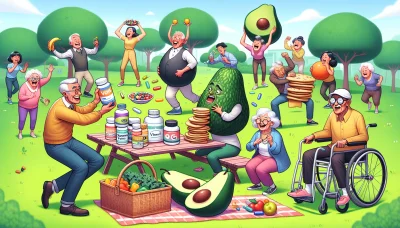High fiber breakfast foods Quiz
Test Your Knowledge
Question of
Understanding High Fiber Breakfast Foods
The Importance of Fiber in Your Diet
Fiber is a nutritional powerhouse, playing a pivotal role in maintaining overall health. It's not just about keeping things moving; fiber contributes to a multitude of bodily functions. A high-fiber diet is linked to a reduced risk of developing chronic diseases such as heart disease, diabetes, and certain types of cancer.
Digestive Health Benefits : Fiber is the unsung hero of digestion. It adds bulk to stools and keeps constipation at bay, but that's not all. Regular fiber intake can prevent digestive disorders like diverticulitis and even provide relief from irritable bowel syndrome (IBS). Truly, fiber is a gut's best friend!
Blood Sugar Regulation : Say goodbye to those pesky blood sugar spikes! Fiber slows down the absorption of sugar, helping maintain steady glucose levels. This is particularly crucial for individuals managing diabetes but benefits everyone aiming for sustained energy throughout the day.
Appetite and Weight Control : If you're on the hunt for weight management allies, fiber should be your go-to. It promotes satiety, meaning you feel full longer after meals. This natural appetite suppressant can help curb overeating and assist in achieving healthy weight goals.
Types of Dietary Fiber
Fiber comes in various forms, each with unique benefits. Understanding these can help you make informed choices about your breakfast foods and beyond.
Soluble Fiber Sources : Soluble fiber dissolves in water, forming a gel-like substance that can lower cholesterol and stabilize blood sugar. Oats, apples, and beans are just a few delicious examples that can kickstart your day with a soluble fiber boost!
Insoluble Fiber Sources : For those seeking improved digestive health, insoluble fiber is key. It doesn't dissolve, instead adding bulk to help food pass more quickly through the stomach and intestines. Whole grains and many vegetables are rich in this type of fiber.
Prebiotic Fiber and Gut Health : Prebiotics are specialized plant fibers that nourish the good bacteria in your gut. These fibers act as fertilizers for a healthy microbiome. Foods like bananas and onions contain prebiotic fibers that support digestive health.
Recommended Daily Fiber Intake
Are you getting enough fiber? Many people fall short of their daily needs, which can lead to health issues over time.
Fiber Needs by Age and Gender : The amount of fiber needed can varymen generally require more than women due to their higher caloric intake. Children's needs increase as they grow older. Guidelines suggest women aim for at least 25 grams per day while men should target around 38 grams.
- Signs of Inadequate Fiber Consumption:
- If you're experiencing frequent constipation or irregular bowel movements, it may indicate low fiber intake.
- An unexplained increase in hunger shortly after meals could mean you're not eating enough fibrous foods to keep you satisfied.
- Persistent high blood sugar readings might be a sign that your diet lacks sufficient fiber to regulate glucose levels effectively.
- Unexpected weight gain can sometimes be attributed to inadequate fiber consumption leading to overeating due to lack of satiety.
To ensure you're meeting your requirements, How to Track Your Fiber Intake: consider using food tracking apps or simply reading nutrition labels carefully. Gradually increasing your intake can prevent discomfort while allowing your body to adjust to higher levels of dietary fiber.
Top High Fiber Cereals to Start Your Day
Whole Grain Cereals
Kickstart your morning with whole grain cereals! They're packed with fiber and essential nutrients that fuel your day right. Whole grains include all three parts of the grain kernel, ensuring you receive the maximum health benefits. From oats to quinoa, the variety is vast, and the potential for a delicious breakfast is enormous!
Don't just take any cereal off the shelf! Look for products that list whole grains at the top of the ingredient list. Check for labels like "100% whole grain" or "whole wheat" to ensure you're getting a truly whole grain product. These cereals are not only rich in fiber but also natural oils, vitamins, and minerals that are vital for your health.
Nutrient Profile of Whole Grains
Whole grains are nutritional powerhouses! They are loaded with dietary fiber which aids in digestion and keeps you feeling full longer. Additionally, they contain B vitamins such as thiamin, riboflavin, niacin, and folate which play key roles in metabolism turning food into energy!
Identifying Whole Grain Products
Finding true whole grain products can be a breeze if you know what to look for. Check for the Whole Grain Stamp from the Whole Grains Council or simply read ingredient lists carefully. The first ingredient should be a whole grain such as "whole wheat flour" or "whole oats."
Portion Sizes and Serving Suggestions
Even with high-fiber cereals, portion control is important. A standard serving size is typically around 1/2 to 1 cup depending on the cereal's density. Pair it with low-fat milk or a dairy-free alternative and fresh fruit for an energizing start to your day!
Bran-Based Options
Bran-based cereals are fantastic sources of dietary fiber which contributes significantly to gut health. Wheat bran, oat bran, and rice bran varieties are among the most popular choices. These cereals often come fortified with additional vitamins and minerals making them an even healthier option.
Health Advantages of Bran
Bran is rich in both soluble and insoluble fiber which promotes regular bowel movements and helps maintain bowel health. It's also known to help regulate blood sugar levels and can contribute to lowering cholesterol a win-win situation for maintaining a healthy lifestyle!
Creative Ways to Enjoy Bran Cereals
- *Mix with yogurt for a crunchy twist. *Blend into smoothies for added texture and nutrients. *Use as a topping on fruit salads or baked goods. *Incorporate into homemade trail mix for an on-the-go snack. *Create cereal bars by mixing bran cereal with honey and nuts. *Substitute bread crumbs in recipes with crushed bran cereal.
Bran Cereal Recipes for Breakfast
Transform your bran cereal into delightful breakfast dishes! Add it into pancake batter for extra crunch or bake it into muffins for a fiber-rich morning treat. You can also layer it in parfaits or simply enjoy it traditionally with cold milk.
Gluten-Free High Fiber Alternatives
If you're gluten-sensitive or celiac, fear not! There are plenty of gluten-free cereals packed with fiber that don't compromise on taste or nutrition. Look out for options like buckwheat, corn, millet, and rice which naturally contain no gluten but still offer that essential high-fiber content.
Understanding Gluten Sensitivity
Gluten sensitivity ranges from mild intolerance to celiac disease an autoimmune disorder where gluten damages the small intestine. Knowing your level of sensitivity is crucial when selecting gluten-free products to avoid discomfort or potential health risks.
Navigating Gluten-Free Labels
Navigating gluten-free labels can be tricky but knowing what to look for makes all the difference. Always check for certifications from reputable organizations like the Gluten-Free Certification Organization (GFCO). They ensure products meet strict standards for gluten-free safety.
Delicious Gluten-Free Cereal Brands
Luckily, there's no shortage of tasty gluten-free cereal brands on the market today! Brands like Nature's Path offer a variety of flavors while Bob's Red Mill provides hearty options like their mighty tasty hot cereal that's perfect for colder mornings.
Delicious High Fiber Fruits for Breakfast
Berries Bursting with Fiber
Berries are a powerhouse of fiber, essential for a healthy digestive system. They come in various forms strawberries, blueberries, raspberries, and blackberries, each offering a unique taste and fiber content. A single cup of raspberries can provide up to 8 grams of fiber, making them an excellent choice for a fiber-rich breakfast.
The fiber in berries goes hand-in-hand with their rich antioxidant properties. The presence of vitamins, minerals, and phytonutrients in these small fruits supports overall health beyond just aiding digestion. They're low in calories yet high in dietary value a winning combination for anyone looking to maintain a balanced diet.
Nutritional Benefits of Berries
Berries are not only loaded with fiber but also pack a powerful punch of vitamins and antioxidants. These nutrients work synergistically to bolster the immune system, reduce inflammation, and fend off chronic diseases. Including berries in your breakfast is an easy way to supercharge your nutrient intake first thing in the morning.
Incorporating Berries into Breakfast Meals
Integrating berries into your morning routine is both delicious and straightforward. Blend them into smoothies, sprinkle over oatmeal or yogurt, or simply enjoy a fresh berry salad. Their versatility makes them an easy addition to virtually any breakfast dish.
Storing and Selecting Fresh Berries
When selecting berries from the market, look for bright colors and firmness signs of freshness and quality. Store them in the refrigerator to maintain their shelf life but avoid washing until you're ready to eat them, as moisture can accelerate spoilage.
Apples and Pears: A Fiber-Rich Start
Apples and pears stand out as excellent sources of both soluble and insoluble fiber. An average apple contains about 4.4 grams of fiber while pears offer slightly more an impressive feat for such common fruits. Starting your day with these can help keep you full and energized.
Comparing Fiber Content in Apples and Pears
Both apples and pears are similar in their fiber content; however, pears slightly edge out apples with around 5.5 grams per medium fruit compared to apples' 4.4 grams. This difference might be small but can be significant when consumed regularly as part of a high-fiber diet.
Creative Apple and Pear Breakfast Ideas
Incorporate apples or pears into your breakfast by dicing them into cereals or baking them into morning muffins. You can also saut slices with cinnamon for a warm and comforting breakfast topping or make a quick fruit compote.
The Role of Skin in Fiber Content
- Don't Peel: The skin of apples and pears contains the majority of the fruit's fiber content; thus, consuming them unpeeled maximizes their nutritional benefits.
- Wash Thoroughly: Always wash the skin well before eating to remove any pesticides or contaminants that may be present on the surface.
- Variety Matters: Different varieties contain different amounts of fiber; choose types like Granny Smith apples or Bartlett pears for a higher fiber intake.
- Savor the Texture: The skin adds texture to dishes, enhancing the sensory experience of your meal while providing health benefits.
Tropical Fruits with High Fiber Content
Tropical fruits are not only exotic and flavorful but also offer an impressive amount of dietary fiber. Fruits like mangoes, papayas, guavas, and kiwis contribute to daily fiber requirements while adding a unique twist to traditional breakfast menus.
Exotic Choices for a Fiber Boost
Mangoes provide about 3 grams of fiber per cup, papayas offer roughly 2.5 grams per cup, while guavas top the chart with up to 9 grams per cup! These tropical delights are sensational options for boosting your morning fiber intake.
Preparing Tropical Fruits for Breakfast
Cutting tropical fruits might seem daunting, but it's quite simple once you learn how! Cube mangoes or scoop out papaya halves for an easy addition to fruit salads or blend them into smoothies for a refreshing start to your day.
Combining Tropical Fruits with Other Breakfast Foods
To create a balanced breakfast plate, pair tropical fruits with whole grains like granola or quinoa porridge. Their vibrant flavors complement bland foods while adding color and nutrition to your first meal of the day.
Nutrient-Packed High Fiber Smoothies and Shakes
Choosing the Right Ingredients for Fiber
To boost your fiber intake, selecting the right ingredients is crucial. Fruits like berries, pears, and apples are high in natural fibers, while greens such as spinach and kale offer a plant-based fiber punch. Incorporating these into your smoothies can significantly enhance their fiber content.
Nuts and seeds are powerhouses of nutrition and fiber. Chia seeds, flaxseeds, and almonds can be easily added to any shake or smoothie for an extra dose of fiber. These small but mighty additions contribute not only to your daily fiber goals but also provide healthy fats and other vital nutrients.
The liquid base you choose for your smoothie can also affect its fiber content. While water is a standard option, using almond milk, soy milk, or coconut water can add an extra layer of flavor and nutrients without compromising on the fiber content.
Best Fruits and Vegetables for Smoothies
- Berries (strawberries, blueberries, raspberries)
- Pears (with skin)
- Apples (with skin)
- Spinach
- Kale
- Banana (for creaminess and fiber)
- Avocado (adds creaminess plus fiber)
Protein and Fiber: The Perfect Match
Incorporating protein into your high-fiber smoothies helps balance macronutrients which can keep you satiated longer. This balance is essential for muscle repair after workouts and for maintaining steady energy levels throughout the day.
Plant-based protein powders like pea or hemp protein are excellent choices that naturally contain dietary fibers. These powders blend well into smoothies without altering the taste too much while boosting both protein and fiber content.
For those who prefer animal-based proteins, whey or casein protein can complement high-fiber ingredients well. However, it's important to choose high-quality protein sources to ensure they do not detract from the health benefits of the high-fiber fruits and vegetables in your smoothie.
Smoothie Bowls as a Fiber-Rich Alternative
Smoothie bowls are not only visually appealing but also a fantastic way to increase your fiber intake. The thicker consistency allows for a variety of toppings that can enhance both texture and nutritional value.
Toppings like granola, coconut flakes, nuts, seeds, and fresh fruit not only add texture but also pack in additional dietary fiber. They transform your smoothie from a drink into a more fulfilling meal.
To make a satisfying smoothie bowl that's rich in fiber, start with a thick blend of fibrous fruits and vegetables. Top it with a mix of seeds, nuts, whole grains, or even a sprinkle of bran flakes to create a meal that's both nutritious and filling.
High Fiber Breakfast Recipes for Weight Management
Oatmeal Variations Packed with Fiber
Starting your day with a high-fiber breakfast can be both delicious and beneficial for weight management. Oatmeal, a versatile and fiber-rich grain, is a fantastic choice. It's not just about the oats; it's how you prepare them that can make all the difference. From overnight oats to slow-cooked porridge, there's an oatmeal variation to satisfy every palate while fueling your body with essential nutrients.
When it comes to oatmeal, the type of oats you choose matters. Classic rolled oats are a popular option due to their quick cooking time and creamy texture. On the other hand, steel-cut oats offer a heartier chew and slightly higher fiber content but require longer cooking times. Both types are excellent sources of soluble fiber, which is known to help reduce cholesterol and stabilize blood sugar levels.
Flavoring your oatmeal doesn't have to mean loading it with sugar. Instead, opt for natural sweeteners like ripe bananas or applesauce. Spices such as cinnamon or nutmeg add depth of flavor without extra calories. Experimenting with these natural sweeteners not only enhances taste but also contributes additional nutrients to your meal.
Your choice of oatmeal toppings can significantly boost the fiber content of your breakfast. Consider adding a mix of fresh fruits, nuts, seeds, or even a spoonful of nut butter for added protein and healthy fats. These toppings not only increase the fiber content but also provide various textures and flavors that keep your morning meal interesting and satisfying.
Egg-Based Dishes with Vegetables
Eggs are a powerhouse ingredient in the kitchen, offering high-quality protein along with essential vitamins and minerals. When paired with vegetables, they create egg-based dishes that are not only high in fiber but also rich in nutrients. Adding vegetables like spinach, bell peppers, or mushrooms to omelets and scrambles turns a simple egg dish into a colorful and filling meal.
The role of eggs in a balanced diet is significant due to their nutrient density and versatility. They can be prepared in numerous ways, making them an ideal base for incorporating various vegetables into your diet. Moreover, eggs contain choline, an important nutrient that supports brain health, further highlighting their place in a nutritious breakfast routine.
- Start with non-stick pans to reduce the need for additional fats.
- Use egg whites or a combination of whole eggs and egg whites for lower calorie intake.
- Increase fiber by adding greens like kale or Swiss chard.
- Mix in fibrous veggies such as broccoli or artichokes for added texture and nutrients.
- Flavor your dishes with herbs and spices instead of salt for health-conscious seasoning.
- Opt for low-calorie fillings like tomatoes or zucchini to bulk up your dish without excess calories.
- Get creative with salsa or pico de gallo as flavorful, low-calorie toppings.
High Fiber Pancakes and Waffles
Pancakes and waffles don't have to be reserved for indulgent weekend breakfasts; they can also be part of a high-fiber diet! By using alternative flours such as buckwheat, almond flour, or coconut flour, you can create pancakes and waffles that are higher in fiber than their traditional counterparts. These flours not only improve the nutritional profile but also introduce new flavors to enjoy.
Sweetening pancakes and waffles naturally is easier than you think! Pureed fruits like bananas or pumpkin can add sweetness along with fiber. Other options include dates or figs blended into the batter. These natural sweeteners contribute additional vitamins and minerals while keeping the glycemic index lower than refined sugars would.
Incorporating Legumes into Your Breakfast Routine
Beans: A Versatile Breakfast Component
Starting your day with beans can revolutionize your morning meal! Beans are not only filling but also pack a punch of protein and fiber. They're incredibly versatile, easily slipping into a variety of breakfast dishes. Whether you prefer savory or sweet, there's a bean-based breakfast waiting for you.
Types of Beans and Their Fiber Content: From black beans to pintos, each variety brings its unique texture and taste to the table. Navy beans are an excellent choice for their high fiber content, while kidney beans add a robust flavor to any dish. Don't forget about the humble chickpea, which offers both versatility and nutrition.
Preparing Beans for Breakfast Dishes: Pre-soaking beans overnight cuts down cooking time and makes them easier to digest. Canned beans are a convenient alternative, just be sure to choose low-sodium options and rinse them well. Mash them into spreads or add whole beans to omelets and breakfast burritos for a satisfying meal.
Beans in Global Breakfast Cuisine: Beans are a staple in many cultures' first meal of the day. Think Mexican huevos rancheros or British baked beans on toastglobal cuisines provide endless inspiration for incorporating beans into your breakfast routine!
Lentils: Quick-Cooking Fiber Powerhouses
Lentils are a breakfast game-changer. They cook faster than most other legumes, making them an ideal choice for quick morning meals. Full of B-vitamins and protein, lentils keep you energized throughout the day.
Nutritional Profile of Lentils: Lentils offer an impressive nutrient profileloaded with fiber, iron, and folate. Their low glycemic index means they help maintain steady blood sugar levels, perfect for a busy day ahead.
Creative Ways to Use Lentils in the Morning: Mix cooked lentils into scrambled eggs or fold them into breakfast wraps for an extra protein kick. They can also be blended into smoothies without altering the flavor but boosting nutritional value.
- Cold Lentil Salads as a Breakfast Option:
- Toss lentils with diced vegetables and a lemony dressing for a refreshing start.
- Add nuts or seeds for added texture and healthy fats.
- Incorporate fresh herbs like parsley or mint to elevate the flavors.
- Make it hearty by adding chunks of cheese or boiled eggs.
- Prep ahead for grab-and-go convenience throughout the week.
Chickpeas: From Hummus to Pancakes
Chickpeas bring diversity to your breakfast table! These little legumes are not just for salads; they can be transformed into various delicious morning treats. High in protein and fiber, chickpeas provide long-lasting energy that's perfect for starting the day right.
The Benefits of Including Chickpeas in Breakfast: Chickpeas offer essential amino acids and are an excellent meat alternative for plant-based diets. Their versatility allows them to be included in numerous dishes, from savory spreads to sweet batters.
Homemade Hummus Variations: Homemade hummus is simple to whip up and can be flavored in countless waysadd roasted red peppers, olives, or even beetroot for a colorful twist on this classic spread. Spread it on toast or use it as a dip with veggies for a nutritious start to your day.
Chickpea Flour Recipes for a Hearty Start: Chickpea flour is gluten-free and perfect for baking hearty pancakes or making savory crepes. It adds substance and nutrition that will keep you full until lunchtime. Experiment with different spices and herbs to create unique flavors every morning!
The Role of Nuts and Seeds in a High Fiber Diet
Almonds, Chia Seeds, and Flaxseeds: Tiny but Mighty
Almonds, chia seeds, and flaxseeds are nutritional powerhouses packed with fiber that can significantly enhance your diet. These small additions are not only rich in fiber but also contain healthy fats and proteins that contribute to overall health.
Chia seeds and flaxseeds are especially known for their high omega-3 fatty acid content, which is crucial for heart health. Almonds provide a satisfying crunch and are a fantastic source of vitamin E, an antioxidant that protects your cells from damage.
Comparing the Fiber Content in Nuts and Seeds
When it comes to fiber content, not all nuts and seeds are created equal. Chia seeds stand out with an impressive 10 grams of fiber per ounce, while flaxseeds follow closely behind. Almonds offer a considerable amount of fiber as well, making them a great snack choice.
Diverse in their fiber profiles, these tiny foods can help you meet your daily requirements effortlessly. Including a variety of nuts and seeds in your diet ensures a broad spectrum of dietary fibers beneficial for digestion.
Tips for Incorporating Them into Breakfast Foods
- Mix into Smoothies: Add ground flaxseeds or chia seeds to smoothies for a nutrient boost without altering the taste.
- Sprinkle on Cereal: Top your morning cereal or granola with sliced almonds or a seed mix to add texture and nutrients.
- Bake into Muffins: Incorporate nuts or seeds into muffin recipes for a satisfying breakfast that's portable and high in fiber.
- Create Parfaits: Layer yogurt with fruit, nuts, and seeds for a visually appealing and fiber-rich start to your day.
Storing Nuts and Seeds Properly
To maintain their nutritional integrity, nuts and seeds should be stored in cool, dry places away from direct sunlight. Refrigeration can extend their shelf life significantly due to their high-fat content which is prone to rancidity.
Airtight containers are essential to prevent oxidation and keep these tiny treasures fresh. Proper storage not only preserves their taste but also ensures that you get the maximum health benefits each time you indulge.
Nut Butters for a Spreadable Fiber Boost
Nut butters are an excellent way to add both flavor and fiber to your diet. They're versatile, delicious, and can be made from virtually any nut. Spread them on toast or fruit slices for an instant nutrient upgrade.
Health Benefits of Nut Butters
Nut butters aren't just tasty; they're filled with nutrients that support heart health and reduce the risk of chronic diseases. They serve as an easy source of protein, healthy fats, vitamins, minerals, and importantlydietary fiber.
Selecting Healthy Nut Butter Options
In choosing nut butters, opt for those with minimal added sugars or hydrogenated oils. The healthiest options list nuts as their primary ingredient with very few additivesthese pack the most nutritional punch.
Creative Uses of Nut Butters in Breakfasts
Nut butters can transform breakfast dishes into richly satisfying meals. Spread them on whole-grain breads or swirl them into oatmeal. For those looking to get creative, nut butter can also be included in pancake batter or as a dip for fresh fruit!
Seed Mixes for Yogurt and Oatmeal Toppings
Crafting the Perfect Seed Mix
A well-crafted seed mix brings together various textures and flavors while boosting your meal's fiber content. Combining chia, pumpkin, sunflower, and sesame seeds can create a mix that's both nutritious and flavorful.
Benefits of Adding Seeds to Yogurt and Oatmeal
Addition of seeds to yogurt or oatmeal exponentially increases the nutrient value of these foods. Not only do they add essential fibers but also supply valuable minerals like magnesium and zinc which contribute to better health outcomes.
DIY Seed Mix Recipes
Making your own seed mix at home allows you full control over ingredients ensuring you reap all the health benefits without any unwanted additives. Experiment with proportions to find the perfect blend that caters to your palate while enhancing your digestive health!
Planning Your High Fiber Breakfast Menu
Structuring a Balanced High Fiber Meal Plan
Starting your day with a high-fiber breakfast can set you on the path to meet your daily fiber requirements and boost digestive health. A balanced meal plan should include a mix of soluble and insoluble fiber, paired with adequate protein and healthy fats for sustained energy. By focusing on whole foods like fruits, vegetables, whole grains, and legumes, you'll be laying the foundation for a nutrient-rich day.
Understanding macronutrient ratios is crucial when planning your meals. Aim for a breakfast that offers a good balance between carbohydrates (with an emphasis on fiber), proteins, and fats. This balance helps regulate blood sugar levels and keeps you feeling full longer. It's not just about quantity; quality matters too. Choose complex carbs like oats or quinoa over processed options.
Understanding Macronutrient Ratios
A deeper dive into macronutrient ratios reveals that for most high-fiber breakfasts, carbohydrates should make up approximately 45-65% of the calories, with fiber-rich foods taking center stage. Protein should account for 15-25%, which supports muscle repair and growth. Healthy fats should round out the meal at about 20-35% of total caloric intake, providing essential fatty acids and aiding in vitamin absorption.
Sample High Fiber Breakfast Menus
A sample high-fiber breakfast menu might include oatmeal topped with chia seeds, almonds, and fresh berries. Another option could be a smoothie bowl made with kale, banana, flaxseeds, and nut butter. These menus are not only rich in fiber but also include a variety of nutrients that contribute to overall health.
Adjusting Your Plan for Caloric Needs
Your individual caloric needs will dictate the portion sizes and ingredients in your high-fiber breakfast plan. Active individuals may require more calories and may opt to add more nuts or seeds to their meals for additional energy. On the other hand, those with lower caloric requirements might focus on fiber-rich vegetables and fruits to keep calorie intake in check while maximizing nutrient density.
Quick and Easy High Fiber Breakfast Ideas
If time is of the essence in the morning, quick high-fiber options can be lifesavers. Try spreading avocado on whole-grain toast or whipping up a berry and spinach smoothie with ground flaxseed. These ideas take minutes to prepare but are packed with nutrients to kickstart your day.
On-the-Go High Fiber Options
- Fruit & Nut Bars: Look for bars that list nuts and whole grains as primary ingredients.
- Veggie Muffins: Bake muffins incorporating shredded vegetables like carrots or zucchini.
- Whole Grain Wraps: Fill a whole-grain tortilla with peanut butter and sliced bananas for a portable feast.
- Dry Cereal: Choose high-fiber cereals that you can eat dry or with plant-based milk in a travel cup.
Prepping Breakfasts Ahead of Time
To ensure you always have high-fiber options ready, consider prepping breakfasts ahead of time. Overnight oats can be made in batches and stored in the fridge for several daysjust grab one on your way out! Similarly, batch-cooking quinoa or roasting sweet potatoes on the weekend can save precious time during busy mornings.
Last-Minute High Fiber Meals
Sometimes breakfast needs to come together in just minutes. For those last-minute meals, having pre-cut fruits or veggies handy makes it easy to throw together a nutritious plate. Quick-cooking items like eggs can be paired with pre-washed greens for an instant fiber boost.
Overcoming Common High Fiber Diet Challenges
Incorporating more fiber into your diet can lead to increased gas and bloating initially as your digestive system adjusts. To minimize discomfort, increase your fiber intake gradually over several weeks, allowing your body time to adapt. Combining fibrous foods with probiotics like yogurt can also help ease digestion.
Dealing with Increased Gas and Bloating
To manage gas and bloating associated with higher fiber intake, consider spacing out fiber-rich foods throughout the day rather than consuming them all at once. Chew food thoroughly to aid digestion and consider using digestive enzymes if necessary. If symptoms persist, consult a healthcare professional.
Ensuring Adequate Hydration
Fiber requires water to move effectively through the digestive tractso it's critical to drink plenty of fluids when increasing fiber intake. Aim for at least eight glasses of water per day; more if you're active or live in a hot climate. Herbal teas are also an excellent hydrating option that can support digestive health.
Finding Variety in High Fiber Choices
Variety is not only the spice of life but also key to sustaining a high-fiber diet without getting bored. Rotate through different types of grains like barley, bulgur wheat or farro each week. Experiment with new fruits and vegetables regularly; there's an abundance of fibrous options waiting to be discovered!












